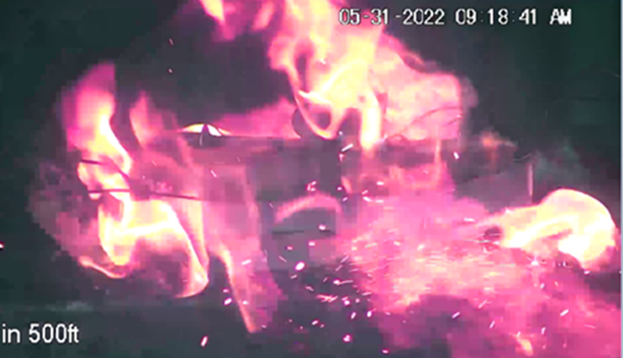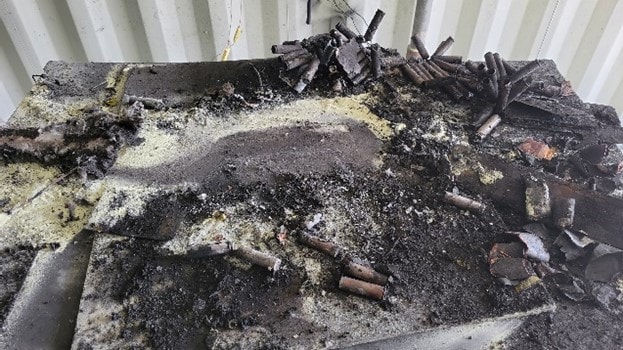Mining Project: Characterizing the Generation and Mitigation of Hazardous Gases during Lithium-ion Battery Failure Events
| Principal Investigator |
|
|---|---|
| Start Date | 10/1/2023 |
| Objective |
With the increase in lithium-ion (Li-ion) battery applications in mining, the significant hazards associated with gas generation during Li-ion battery failure events have become a significant health and safety concern for the industry. This study is intended to address the research gaps related to the gas generation of Li-ion batteries under different abuse conditions and relevant mitigation strategies for the mining industry. The overall research objectives are (1) to characterize gas generation from Li-ion batteries used in battery electric vehicles during a battery failure event and identify the major parameters that affect the release of gas, and (2) to identify mitigation strategies that can reduce gas hazards and protect U.S. mineworkers. This research will generate scientifically based experimental data on the compositions, durations, generation rates, and amounts of potentially hazardous and flammable gases released from Li-ion battery failure events for different battery chemistries. The results will also show how the major parameters, such as battery chemistry, state of charge (SOC), and battery size will affect the gas generation processes. Engineering control and administrative mitigation strategies will be developed to reduce the gas hazards. |
| Topic Areas |
Research Summary
Approach
This study will use analytical, experimental, and numerical methods to achieve the research objectives. First, researchers will complete a thorough, systematic review of the literature and hold discussions with interested parties. Researchers will use the information to scope the first set of laboratory studies needed to develop the methodology to identify and measure gases from Li-ion battery failure events using the Fourier-transform infrared spectroscopy (FTIR) technique. The FTIR will then be used to quantify the amounts of gases generated at different failure stages (i.e., venting, thermal runaway, fire, suppression) and by different battery configurations (i.e., battery chemistry, battery size, and SOC). The Li-ion battery tests will be conducted inside a hood calorimeter in the Pittsburgh Mining Research Division (PMRD) Fire Suppression Testing Facility. FTIR analysis will be conducted for the gas samples from the exhaust duct for potentially hazardous and flammable gases such as CO, HF, HCL, HCN, NO, SO2, POF3, CH4, C2H4, and C2H2. Gas generation rates at each stage will be calculated based on the amounts of gas generated and the duration of each stage. Exhaust gas velocity will be measured using a hot-wire anemometer, the gas temperature will be measured using a thermocouple, and oxygen concentration in the duct will be measured using an infrared (IR) gas analyzer. These data will be used to calculate the heat release rate from the thermal runaway and the fire.
The experimental data on the generation of gases will be used to conduct a hazard analysis to determine appropriate hazard mitigation strategies. Researchers will qualitatively and quantitively estimate the risks of the hazards present during a Li-ion battery failure event, specifically focusing on mineworkers, first responders, and firefighters. Based on the hazards and risks, researchers will identify relevant technological, administrative, and personnel controls to mitigate these risks. Mitigation solutions will explicitly include personal protective equipment (PPE). Experimental results on the amounts of gases generated will also be used to conduct numerical modeling to develop ventilation control measures to remove and prevent the spread of smoke and potentially hazardous gases in a mine ventilation network. Simulations will be conducted to study the designed incident scenarios and to examine potentially hazardous gas spread throughout the mine ventilation network. Based on the simulation results, minimum airflow velocity will be determined to prevent smoke and gas rollback in low-flow cases. Additionally, minimum airflow quantity will be determined to dilute the generated gases from a battery electric vehicle (BEV) battery failure event to below the maximum allowed levels.
Milestones and Accomplishments
| Description | Audience | Year |
|---|---|---|
| Will characterize the potentially harmful gases generated at different stages of a Li-ion battery failure event | Mine safety personnel, BEV manufacturers, academia | 2024 |
| Will determine effects of battery chemistry, size, and state of charge on hazardous gas emissions | BEV operators, mine safety personnel, Mine Safety and Health Administration (MSHA) | 2025 |
| Will make recommendations on emergency response and mitigation strategies for potentially hazardous gases during a battery failure event | Health and safety professionals at mining operations, first responders, MSHA | 2026 |
Planned Impacts and Outcomes
Based on extensive experimental results on hazardous gas generation during Li-ion battery failure events, recommendations on the selection of appropriate PPE during a battery thermal runaway or fire event in an underground mine will be made through a comprehensive gas hazard analysis. Guidance on possible ventilation control measures to prevent potentially hazardous gas from spreading in a mine will be developed through numerical modeling. These scientific data and mitigation strategies developed from this research project are critical for mine companies to developing an appropriate battery fire emergency response and management plan to protect mineworkers and train their safety personnel.
The scientific data and guidelines from the planned research can also be used by mine safety regulatory agencies such as MSHA and industry trade groups such as the GMG (Global Mining Guidelines) group to evaluate safety hazards related to various Li-ion battery applications and to develop battery safety standards and guidelines for Li-ion battery fire emergency response plans. Additionally, these results may help BEV manufacturers better design battery safety and management systems for the mining industry. Through project researchers working with the mine companies, mine safety regulatory agencies, and industry groups, the results from this project are expected to make a significant impact on reducing the hazard of potentially harmful and flammable gases released from Li-ion battery failure events and protecting mineworkers.
Outputs
Outputs will be in the form of peer-reviewed journal articles, conference proceedings, and technical presentations related to hazardous gas generation characteristics during Li-ion battery failure events, the effects of battery chemistry, size, the SOC on gas emissions, and mitigation strategies for reducing toxic gas hazard and protecting mineworkers during a battery fire emergency. The technical presentations will aim for SME Annual Conferences and North American Mine Ventilation Symposiums to reach out to the U.S. mining industry.
Supporting Visuals

Li-ion battery cells exploded during a battery fire test in the PMRD Fire Suppression Test Facility with the 12V nickel manganese cobalt (NMC) battery pack.

Scattered Li-ion battery cells after a battery fire suppression test in the PMRD Fire Suppression Test Facility with the 24V NMC battery pack.
- Coal-Dust Explosion Tests in the Experimental Mine 1919 to 1924, Inclusive
- Evaluation of the Bagged Stone Dust Barrier Effectiveness in a Bord and Pillar Mine
- The Explosibility of Coal Dust
- Explosion Pressure Design Criteria for New Seals in U.S. Coal Mines
- Progress Toward Improved Engineering of Seals and Sealed Areas of Coal Mines
- Rock Dusting Considerations in Underground Coal Mines
- Technology News 489 - Reducing the Danger of Explosions in Sealed Areas (Gobs) in Mines
- Technology News 515 - Float Coal Dust Explosion Hazards
- Technology News 535 - NIOSH Releases New Educational Video: Escape from Farmington No. 9: An Oral History
- Use of Ground Penetrating Radar and Schmidt Hammer Tests to Determine the Structural Integrity of a Mine Seal